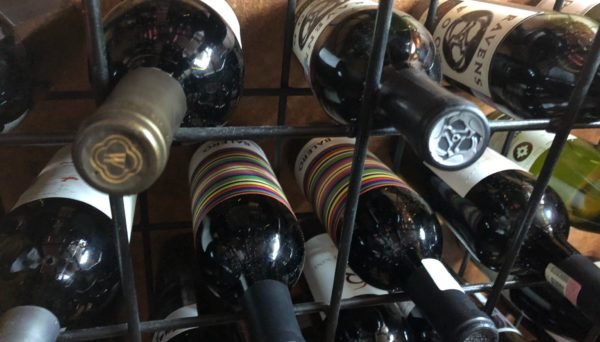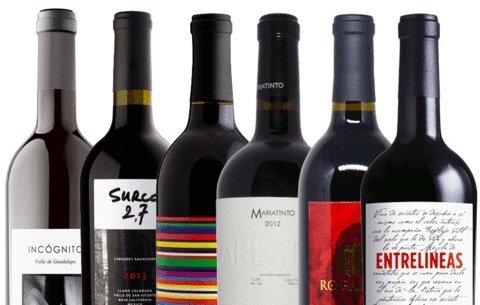I still read the New York Times. Not every Sunday but some Sundays. And yes, I would still prefer newsprint stains on my fingers, but…well…the electronic version is, not only more convenient, but a helluva lot cheaper. The page with the Times bestseller list is never one I go to purposefully but, somehow, I always seem to stumble on it. I can easily skip the fiction. But never the non-fiction list. And if there are any new books about music, films, food or drink, I’m ready for a trip up the Amazon.
Recently, the online wine retailer Mercado de Vinos started publishing bestseller lists and, just like in the Sunday Times, I had to check them out.
As one-time leader La Europea gets more and more buried under their bricks and mortar retailing, Mercado de Vinos is becoming the go to place for Mexico’s best wine selection. Part of the bestseller lists that they recently published were six of their top-selling Mexican reds. I thought, at the very least, I wanted to try a bottle of what the rest of Mexico is drinking and thought you might want me to share my opinions of them.

Estación De Oficios El Porvenir Incógnito. $245.
The first of the six is Incógnito, definitely no stranger to me. Incógnito is the Mexican red that I’ve probably consumed more bottles of than any other Mexican wine. I was introduced to the wine by Antonio Torres, who now manages San Miguel restaurant Zumo, about five years ago. Still today, Incógnito is the only Mexican wine I’ve ever ordered by the case.

I always think of Incógnito as Mexico’s mystery wine. To the best of my knowledge (which, I admit, isn’t very good when it comes to Incógnito), this wine is made at a winemaking school in Valle de Guadalupe. How they then get such consistency, year after year, I’m not sure. But I am sure, after five years of this becoming my most consumed Mexican red, it’s one of the country’s very best values.
What I like is how much fresh fruit the wine has. Cabernet Sauvignon, Zinfandel and Grenache are the grapes and there’s no barrel aging. The plummy, peppery Zinfandel characteristics really come through. And Zinfandel may just be my favorite grape.

Viresa Surco 2.7 2013. $199.
Incógnito may be my most consumed Mexican red ever but the only reason Surco 2.7 is in second place is because I just discovered it a year ago.
Since the late Seventies, when winemaking became a relatively important industry in Mexico, this country has been struggling with what grape varieties are best suited to the climate. Camilo Magoni is one of Mexico’s most well-known winemakers, spending decades with major producer L.A. Cetto. In an interview with Amanda Barnes of “Around The World In 80 Harvests”, she reveals that Magoni had experimented with 112 different grape varieties.
At the low end of the price levels, I think Camilo Magoni has found one of the three or four most suitable varieties with his choice of Cabernet Sauvignon in the Valle de Guadalupe. Vinícola Regional de Ensenada (VIRESA) is a collective, supplying grapes and juice to other producers as well as marketing their own labels including this 100% Cabernet Sauvignon. Viresa Surco 2.7 spends 12 months in the barrel and a minimum of 12 months in the bottle before it is retailed.

I think the reason Surco 2.7 is so good is because of carbonic maceration. Now I’m not sure I exactly understand what carbonic maceration is (or do I want to) but in the simplest of terms, it means that, instead of adding yeast to start fermentation, you use the entire grapes instead of just the juice and transform the sugars into alcohol naturally. All you really need to know is that the process produces a very fresh and fruity wine which is what I want in a cheap and cheerful red.

Mariatinto 2012. $589.
What hit me me first about Mariatinto being one of Mercado de Vinos’ six top selling wines was the price. Wines that cost $589 don’t make bestseller lists. Wines under $300 make bestseller lists.
So what makes Mariatinto so special? What makes so many people shell out so much?
The winery is owned by Guillermo González Beristaín, the owner of the celebrated Pangea and five other restaurants in Mexico and Humberto Falcon, who, since 1998, has been dedicated to the importing and marketing of wines in Mexico.

Humberto told me, “The first harvest resulted from an assembly of wine barrels made by other producers. Little by little we have been integrating, first studying oenology in 2005; then arranging vineyard rental contracts and taking control of the aging of our wines; up until today, where we control the grapes we harvest, the winemaking processes, the aging, assembly and the bottling.”
Humberto and Guillermo made their first Mariatinto in 2002 and, each year, the blend of red grapes has changed slightly. Tempranillo, Grenache and Syrah have always been the primary grapes but the secondary grapes have changed frequently. The blend of the 2012, currently being sold at Mercado de Vinos. consists of 30% Tempranillo, 15% Syrah, 15% Grenache, 10% Carignan, 10% Mouvedre, 10% Petite Syrah and 10% Cabernet Sauvignon.
“Our main objective is to make a wine consistent with the years, high quality and, above all, a balance in the mouth between tannins, acidity, fruit and alcohol that makes it versatile in terms of pairings”, said Humberto.
By using so many different grape varieties, there are many different fruit nuances on the nose and tongue including cherry, strawberry, raspberry and plum. 12 months in French oak adds a complexity and sophistication that, despite some very different grapes being used, reminds me of some of the best blends from France’s Rhone Valley.
And that big price? Well I’m thrilled I tried one bottle but I probably won’t be buying it regularly. It’s very rare that I ever spend that much money on a bottle of wine. And, at that price, there’s a lot of very good competition for my pesos in the rest of the world. But a huge bow of congratulations to Humberto and Guillermo for their success.

Entrelíneas 2016. $224.
Almost every winery and every winemaker take their wine very, very seriously. Much too seriously in a lot of cases.
The fourth wine on the list, from Vinícola Santa Elena and winemaker Aurelio Garcia, doesn’t seem to. And I really like that. Though I suspect that the sophisticated and savvy marketers at González Byass should be receiving at least some of the credit. Santa Elena is part of this large Spanish conglomerate and Gonzálea Byass has a long list of wineries in their portfolio.
You don’t have to go entre líneas or between the lines to make sense of these quotations: “a wine aimed at the youth market”, “it is a light and uncomplicated wine”, “for the one who is in the process of learning or in his first approaches to wine”. Wineries don’t talk like that. They almost always talk what we call winespeak to wine snobs like me. And we probably make up less than 1% of Mexico’s wine market.
99% of the world doesn’t want to know exactly how many months their wine has been aged in barrels; whether those barrels were made out of French, American or Hungarian oak; or whether those barrels were new or two or three years old.
The wine comes from around Aguascalientes, a town not too far northwest of San Miguel de Allende and, though the area is not a notable wine-growing area, Vinicola Santa Elena makes a good argument as to why it should be.
Fernando Azuara, Public Relations Manager of Santa Elena, told me, “The vineyards are located from 1800 meters to 2000 meters above sea level, which compensates for the more southerly latitude. The hours of sunshine are also important; the intensity of the sun, together with the altitude, make the grapes generate a thicker skin that gives great color to our wines.”

“Another of the peculiarities of Aguascalientes are the temperature changes between day and night,” Fernando continued. “In Winter, they range from -1 or 0 C in the early morning to 24 in the day; in Summer, they range from 10 degrees C in the early morning to 30 or 32 in the afternoon.”
I like what the climate does to Entrelineas. I like the blend of 50% Malbec, 40% Syrah and 10% Nebbiolo. I like all of the fresh berry fruits on the nose. I like the wine. I think it’s a bargain at the price. I think it’s not just smart marketing, I think I’m not the only wine snob who would like it.
 e
e
Balero. $335.
We move back to Baja California and, more specifically, the Valle de San Vicente for number five on Mercado de Vinos’ bestseller list.
Balero is another one of those somewhat obscure wineries where you’re not sure exactly what they’re contributing to the end product other than some smart marketing, including a label with colors that seems to yell out “come drink me” from my miniature wine cellar under the stairs.

The winery says that they “work with local producers” and “are a group of Mexican wine enthusiasts who came together to create a quality wine at a fair price”.
I like that Balero isn’t trying to create seven or eight different wines like some small Mexican wineries. There are simply two choices, a tinto and a blanco.
The red is a blend of three classic grapes, one with a Spanish pedigree, the other two with French, in a combination of 40% Tempranillo, 30% Cabernet Sauvignon and 30% Merlot.
Raspberries are the dominant fruit on the nose and the aging of Balero tinto for 12 months adds chocolate and vanilla to the nose. I might like to see Balero priced at about 50 pesos less but, otherwise, I think it well deserves its popularity.

Roganto Nebbiolo de la Baja California. $315.
It’s a question I get asked a lot: “So which grape do you think performs best in Mexico?” I usually hedge my answer, naming three, maybe four different grapes, but one of them seems to always be Nebbiolo.
Nebbiolo is usually associated with Northern Italy and, more specifically, the Piedmont region and Barolo and Barbaresco wines. Serious plantings of Nebbiolo began in Baja California about 20 years ago and, though there isn’t a single Mexican wine made from the grape that would compare with a great Barolo, even a good Barolo is about three times the price of the last of the top six on the list, Roganto Nebbiolo.
There are some distinct similarities between the soil and climate of the two regions, particularly the moist breezes that come from the Ligurian Sea to Piedmont and the Pacific to Baja California as harvest time approaches.

Roganto is one of the oldest and most sophisticated operations in Mexico. The ever expanding winery has been commercially producing since 2001 and markets close to 20 different wines.
I haven’t even tried half of them but, from what I have tasted, for the price, the Nebbiolo is my favorite. It’s young for a Nebbiolo and hasn’t taken on the brick-red color that’s characteristic of the grape but it has the typical violets and roses aroma and cherry taste.
It took Mexican wines quite a while to be accepted in their own home but I now feel that the welcome mats are permanently out. At Mercado de Vinos, in addition to packaging six top selling Mexican reds, they package six of their top selling reds overall. One is from France. Two are from Spain. One is from the U.S. And two, Surco 2.7 and Balero, are Mexican. Even five years ago, it would be unheard of for two Mexican wines to be among a retailer’s bestsellers.
If you look at Mercado de Vinos total offering of red wines, you’ll find 228 that were made in Mexico. Ten years ago, I would have had a problem finding a retailer with 28 Mexican reds.
Now a book being a bestseller is no guarantee that you’ll enjoy it. And the same goes for wines. But when you have over 200 to choose from, if you’re like me, you need help and, so far, I’m six for six with Mercado de Vinos best-selling Mexican reds.
You will find all six of the bestselling wines at mercadodevinos.mx. Like those ads often say, prices are subject to change without notice.


Thanks so much for the info. Have you purchased any of those wines here in SMA? If so, could you share which ones and where you bought them.
Thanks,
Connie
I’ve seen some in the past but don’t know of anyone that’s stocking any of them in San Miguel now. I have switched almost exclusively to online sources due to the much larger selection.
Glen,
Your fondness and propensity for Zinfandels and Nebbiolos tells me your taste buds are a lot like mine. Nice reviews. I will definitely have to try the Incógnito and the Roganto Nebbiolo. Thanks.
Does anyone do tours to the Guadalupe Valley?
There are lots of tour operators out of Ensanada if you fly up to Tijuana but I don’t think anyone is doing them out of San Miguel these days.
Hi Glenn, Thanks so much for this great information. I would love to ship some of these wines to my house in SMDA. Could you share a website in Mexico where I could buy these wines?
mercadodevinos.mx The only complication I’ve found is someone has to be home to accept the FedEx delivery.
Glenn, love your blog! Wife and I are in SMdA all of March. Do I need a Mexico issued credit card to sign up with mercaadodevinos.com? Many thanks!
No. Foreign cards are fine.
Thanks! Will definitely sign up